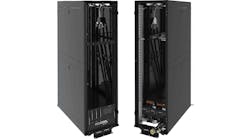There are many layers and facets to edge computing, which is the focus of a growing list of companies, including everyone from startups to the largest cloud platforms. As a result, edge strategies will drive an active season for mergers and acquisitions.
That’s true for the data center sector, as seen in today’s announcement that high-density hosting specialist ScaleMatrix will acquire Instant Data Centers (previously Elliptical Mobile Solutions) which makes ruggedized micro-modular data centers that can support extreme workloads outside a traditional colocation environment.
The deal allows ScaleMatrix to offer high-density hosting in one of its four regional data centers, or on a customer premises or remote site. Instant Data Centers brings several new form factors to the specialized cooling cabinets offered by ScaleMatrix.
Acquiring Instant Data Centers “sets the stage for us to be able to help customers truly deploy any hardware, at any density, anywhere,” said Chris Orlando, co-founder and CEO of ScaleMatrix. “Our clients are increasingly requiring their IT resources to be closer to where the decision processes and data creation is occurring, especially as artificial intelligence continues to gain traction.”
Both ScaleMatrix and Instant Data Centers/Elliptical focus on air-cooled enclosures that tightly manage airflow, allowing them to support high-density server installations with rack densities in excess of 40 to 50 kW.
ScaleMatrix is a San Diego-based colocation and cloud company built atop a custom cabinet design known as Dynamic Density Control. The company’s focus on high-density hosting has proven to be a good fit with San Diego’s active cluster of genomics and life sciences companies.
Taking High-Density Hosting National
In recent months, ScaleMatrix has expanded across the country, creating a network of four regional data centers with up to 57 megawatts of capacity. The most recent new sites are in Charlotte and Seattle.
The Instant Data Centers acquisition continues that expansion, adding new form factors and capabilities to address edge computing, which extends data processing and storage closer to the growing universe of devices and sensors at the edge of the network.
“This was a great addition and a logical next step for us,” said Orlando. “We’re starting to see customers that have colo with us that want to put one of those units in one of their sites.
“The market dynamics are changing, and the change requirements are coming from the customer,” he added. “If you can provide them a small modular data center, that’s a win. This a solution that’s ready out of the box. We’re making some tweaks to their platform, but it can solve a bunch of edge problems.”
“The integration of the IDC product line into the DDC cabinet technology portfolio brings mobility, ruggedization, and variable form factor capabilities to an already powerful line up of modular data center solutions,” said Gavin Miller, CEO of Instant Data Centers.
“ScaleMatrix and DDC set the standard for advanced, modular data center capabilities, as is evidenced by rapid growth of their national data center footprint and growing number of enterprise and edge data center installations,” Miller added.
The Instant Data Centers mobile micro data centers will become part of the R-Series line at ScaleMatrix. (Image: ScaleMatrix)
Instant Data Centers offers enclosures housing a number of rack units, with designs for 12U, 24U and 30U cabinets, compared to 45U for the standard ScaleMatrix cabinet. The IDC products will be integrated into the DDC family of solutions under the R-Series, emphasizing the line’s ruggedized features.
The Secret Sauce is in the Cabinet
The key building block for ScaleMatrix is the Dynamic Density Control (DDC) cabinet, which was designed for efficiency but also supports extreme density. The DDC is an extra-wide enclosure with two compartments: a bottom compartment housing a four-post rack (with extra depth to accommodate HPC servers), and a top compartment containing a heat exchanger.
The six-foot deep cabinet is sealed, with air filters, humidity control and fire suppression handled within the enclosure. Air is recirculated within the cabinet, with cool air delivered to server inlets via an 8-inch air plenum in the front of the rack. When exhaust heat exits the back of the equipment, it rises to the cooling compartment and is cooled and recirculated.
The use of containment allows ScaleMatrix to maintain temperatures within a 2 degree temperature range throughout the rack. The temperature within the rack is closely monitored and managed by an in-house DCIM (data center infrastructure management) system, which can regulate the temperature by adjusting a variable control valve on the cooling loop.
Last year ScaleMatrix spun out DDC into a separate brand, positioning it as the product side of the business, while ScaleMatrix continued as the services business. It also developed an edge version of the DDC for off-site data requirements.
When it launched in 2010, Elliptical Mobile Systems (EMS) was a pioneer in Micro Modular Data Centers, smaller enclosures that can house a single rack of IT equipment and a heat exchanger. In early testing, the company’s mobile enclosures handled IT loads from 20 kW to 80 kW. Elliptical units featured fire suppression, electronic security, environmental monitoring and building automation.
Most importantly, they were designed to be deployed outdoors, a capability that was showcased by AOL when it deployed several Elliptical units on outdoor slabs in Northern Virginia in an early version of an “edge” distributed computing strategy. In 2012, AOL’s outdoor servers performed flawlessly during tropical storm force winds during SuperStorm Sandy.
But demand never grew substantially. Elliptical filed for bankruptcy in 2015, and in 2016 its assets were acquired by Instant Data Centers.
Not Just for HPC Anymore
ScaleMatrix is expanding to pursue the growing opportunity for high-density Colocation space, which has traditionally been focused on HPC (high-performance computing), the energy and life sciences industries, and cryptocurrency mining.
Beyond those niches, data center rack density has remained fairly stable in recent years, but that’s beginning to change with broader adoption of artificial intelligence and machine learning, along with the use of GPUs and other specialized hardware. Facebook, Microsoft and Google are leading a punch into AI as a way to add intelligence to products and services across their vast platforms.
Chris Orlando, a co-founder of ScaleMatrix, in the company’s San Diego data center and its distinctive central NOC. (Photo: Rich Miller)
Adoption of AI is now spreading into the enterprise sector, boosting interest in on-premises hardware to support these workloads. An example is NVIDIA’s DGX system, a “supercomputer in a box” offering designed for corporate data centers.
“The workload density is going up,” said Orlando. “It’s not longer just an HPC thing, but is trickling down into the enterprise. They need to get compute closer to the workloads, which is driving requirements. We believe there’s going to be a tremendous number of requirements for edge AI.”
There’s also been interest in liquid cooling solutions, including systems that bring liquid to the chip, racks featuring rear “cooling doors” using chilled water, as well as immersion technologies that submerge servers in dielectric fluid.
“In my opinion, they’re going in the wrong direction,” said Orlando, who believes custom air-cooled cabinets like DDC and IDC offer quicker, less complex solutions. “Everyone wants to move quickly,” he said. “It adds time to your deployment. We think we’ve got a better solution.”






